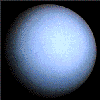|
~
Uranus |
||
-- Uranus is one of the 'gas-giants'. Uranus is the seventh planet from the Sun in our solar system. The third largest planet, Uranus is one of the "gas giant" planets; the other "gas giants" are Saturn, Jupiter, and Neptune. Hydrogen, helium, water, and probably methane, ammonia, rock, and metal make up Uranus. Small amounts of methane in the planet's upper atmosphere cause it to have a blue-green color when viewed through a telescope. When Sir William Herschel discovered Uranus by accident in 1781, it became the first planet discovered since the times of the Greeks and Romans. This is interesting because Uranus is the furthest planet from Earth that can be seen without a using a telescope, yet the ancient astronomers didn't discover it. Uranus was originally named "Star of George" in honor of King George III of Great Britain. The modern name of the planet comes from the Greek god who was the first god of the sky. Uranus' mass is about 14 times greater than the Earth's mass and its density is about one-quarter as great as our planet's density. The diameter at Uranus' equator is more than four times the Earth's diameter. On March 10, 1977, astronomers discovered that Uranus had rings. The planet is surrounded by at least 10 dark rings, which range in width from less than 3 miles to over 60 miles (5 km to 96 km). The rings are very different from Saturn's bright rings; they are made of unusually dark material. From November 1985 to February 1986, Voyager 2 visited Uranus. It is the only spacecraft to have ever visited the planet. Instead of spinning like the other planets, Uranus spins on its side. It's almost as if the planet had been tipped over. Because of this, one of the planet's poles faces towards the Sun, then its equator faces the Sun, and finally its other pole faces the Sun. Therefore, day and night on Uranus are very different than day and night on Earth. In fact, a "day" on the planet's polar regions lasts 42 years and is followed by 42 years of "night." A year on Uranus is equivalent to 84 years on Earth. Uranus' has 15 known moons. They are made mostly of ice and have many craters. Miranda, Ariel, Umbriel, Titania, and Oberon are the planet's major moons.
|
||

